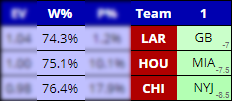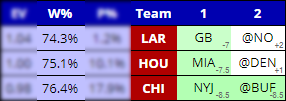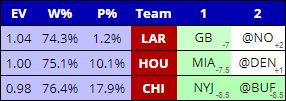NFL Survivor Pool Strategy 101
Survivor football pools are fascinating in that the rules are simple, yet the strategy can be so complex. This unique combination makes it possible to gain an edge over the average player. By making picks each week with a positive expected value (+EV), an advantageous player can be profitable over the long run.
When I joined my first survivor pool in 2008, I was instantly hooked and have been exploring the strategy ever since (and running SurvivorGrid since 2009). This guide is what I consider to be the basic overall strategy to maximize your chance of success in a survivor pool.
There are three main things to consider when determining which team to pick each week:
1. Win Probability (W%)
The first (and most obvious) factor to consider is the Win Probability (W%), which represents how likely a team is to win the current week. It is calculated based on public betting lines and displayed on the left side of the grid.
Often a novice player might only use this factor when deciding who to pick. That makes sense, since choosing the team most likely to win their game does maximize the chance to make it to the next week. However, that is not the goal in a survivor pool.
 Based on W%, picking CHI gives you the best chance to advance to the next week.
Based on W%, picking CHI gives you the best chance to advance to the next week.
2. Future Value
The second factor to consider is the Future Value of the team. Since you can only pick a team once, it may be more optimal to save the highest W% team of the current week for a future week where it provides a more significant advantage, while settling for a slightly lower W% team.
A crucial thing to consider here is the size of your pool, and when you think it might end. If you are in a large pool with hundreds of players, your pool may likely last the whole season. If there are just five people left alive, then your pool may only last a couple more weeks, in which case there is no reason to save a team for much later in the season.
The grid allows you to visualize the strength of matchups for the entire season and plan out an optimal path. Doing so, you can maximize the chance that you survive until the end of the season (or the expected final week of the pool). However, that also is not the goal in a survivor pool.
 Looking ahead, CHI is by far the best option in Week 2, so picking HOU (the second best W% option) gives you the best chance to survive past Week 2.
Looking ahead, CHI is by far the best option in Week 2, so picking HOU (the second best W% option) gives you the best chance to survive past Week 2.
3. Pick Percentage (P%)
Possibly the most important (but often ignored) factor to consider is the Pick Percentage (P%) of a team, which is how many other players are expected to choose the team in question.
If you pick the team which maximizes your chance to survive until the end of the season (or the expected final week of the pool), but every other player does the same, you have not improved your odds at all. If the popular pick wins - everyone advances, and if the pick loses - everyone is eliminated. By instead going against the crowd, and choosing a team with a bit lower W% but also a much lower P%, you can improve the odds that you survive to the next week with less other players doing so along with you. This strategy will maximize the chance that you will survive longer than all other players, which is the real goal in (and of course how you win) a survivor pool.
 By looking at P% and EV as well, LAR actually provides the best value for Week 1. You are slightly less likely to survive past Week 2, but you will be in a better position to win the pool.
By looking at P% and EV as well, LAR actually provides the best value for Week 1. You are slightly less likely to survive past Week 2, but you will be in a better position to win the pool.
The grid shows P% on the left side, and allows you to toggle between the consensus pick percentages from some of the popular hosting services. You can also compare them in one place and see trends here.
Wait! How does a picking a lower W% team help me win?
It may seem counterintuitive at first, but here is a basic example that helps illustrate the idea: Imagine a pool with 10 players and just one game to pick from, with NE being 80% likely to win against MIA. As such a big favorite, all 9 other players have picked NE.
Who should you choose?
NE clearly gives you the best chance to survive the week, but picking MIA actually gives you a better shot to win the pool! Picking NE means that if you survive, then so does everyone else, so your odds of winning are still 1/10 (10%). By choosing MIA, there is an 80% chance you will be eliminated (ouch), but 20% of the time you win the whole pool that week! You are taking on more risk of early elimination, but you have also doubled the chance that you will win the pool.
The above is an extreme example, but the same concept applies across a full slate of games.
Expected Value (EV)
So how do you know when a team is too popular and should be avoided? SurvivorGrid does all the calculations for you, using the W% and P% of each team and computing the Expected Value (EV) of that pick for the current week. There is a basic example in the FAQ if you are curious about the math behind it.
If the "value" of your pool entry is assumed to be 1.00 heading into the week, the EV column shows the expected value of picking that team. For example, if you are 1 of 10 people still alive in your pool (10% chance of winning it), by selecting a team with EV of 1.32, your odds have improved to a 13.2% chance to win the pool.
Using a combination of EV (which incorporates both W% and P%) as well as looking ahead at the future value (based on how long you expect your pool to last) is the best way to maximize your edge in a survivor pool.
Other Factors To Consider?
Should I avoid road teams? Divisional matchups? What about injuries? Bad weather?
Many other factors may seem important, but these are all incorporated into W% already. The win probability is based on public betting markets, which react in real-time to any factors which may affect the game. If there is a sudden change (e.g. QB is injured last minute), the data on the grid will be updated as soon as the betting line moves (we update hourly).
An argument could be made against the ability of public market betting lines to predict game outcomes. But if you believe there are other factors that can consistently beat betting odds, you are probably wasting your time playing in survivor pools.
Realistic Expectations
No matter how well you pick, survivor pools still come down to a lot of luck. Anything can happen once the game kicks off (that's why we watch, right?).
If you are in a pool with 14 other people of equal skill, you can expect to win it just once every 15 years on average. By picking more strategically, you can increase this, but even if you picked well enough to 5x your odds compared to the average player, you would still only win the pool 1 in every 3 years.
There is no way to guarantee short term success, but by continuing to make positive expected value (+EV) picks season after season, over the long term, you can become profitable.
Multiple Picks Strategy
One way to improve your chance of short term success is to play multiple entries in the same season. This can be done with multiple entries in the same pool (if allowed), or just as easily with entries in different pools.
By splitting up your picks between the top options, you will sacrifice a bit of EV but can significantly increase your odds of at least 1 of your entries surviving to the next week.
 If you have 2 entries and pick LAR with both, you're total EV is 2.08 and you have a 74.8% chance that both entries survive Week 1. If you split your picks between LAR and HOU, you total EV drops to 2.04, but you now have a 1 - (1 - 0.743)*(1 - 0.751) = 93.6% chance that at least 1 of your entries survives Week 1.
If you have 2 entries and pick LAR with both, you're total EV is 2.08 and you have a 74.8% chance that both entries survive Week 1. If you split your picks between LAR and HOU, you total EV drops to 2.04, but you now have a 1 - (1 - 0.743)*(1 - 0.751) = 93.6% chance that at least 1 of your entries survives Week 1.
It is not always optimal to split your picks, however. Depending on how much EV you are giving up, it may be better to pick the same team with more than one entry.
Wrapping It Up
Survivor pools are a great way to add a bit of excitement to the NFL season, and using the strategy outlined above it is also possible to play with an advantage and win more often than the average player. I hope you find this guide and web site useful, and I welcome any feedback.
Good luck in your pool!